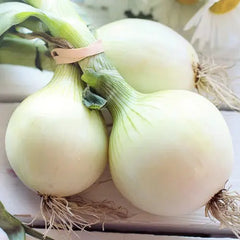White Onion Seeds are used to grow white onions, which are known for their milder, sweeter flavor compared to yellow or red onions. They are a versatile ingredient in many dishes and can be used raw in salads, sautéed, or caramelized. Here’s a comprehensive guide on growing and using white onions from seeds:
Characteristics of White Onions:
- Appearance: White onions have a smooth, white skin and white flesh. They are typically round and can range in size from small to large.
- Flavor and Texture: They have a milder, sweeter taste compared to other onion varieties and are less pungent when raw. They become sweeter as they cook.
Growing Tips:
- Climate: White onions prefer cool to moderate temperatures for optimal growth. They are typically grown as a cool-season crop and can be started in early spring or late summer for a fall harvest, depending on your climate.
- Soil: They grow best in well-drained, loamy soil with a pH of 6.0 to 7.0. Enrich the soil with compost or well-rotted manure before planting to improve fertility and drainage.
-
Planting:
- Starting Seeds: Start seeds indoors 8-10 weeks before the last expected frost date. Sow seeds in seed trays or pots, covering them lightly with soil. Keep them in a warm, sunny location or under grow lights.
- Transplanting: Once seedlings have 2-3 true leaves and outdoor conditions are suitable, harden them off by gradually exposing them to outdoor conditions. Transplant them outdoors when they are 4-6 inches tall and after the last frost date. Space plants 4-6 inches apart in rows that are 12-18 inches apart.
- Watering: Keep the soil consistently moist but not waterlogged. Onions need regular watering, especially during bulb development. Avoid getting water on the leaves to prevent diseases.
- Fertilization: Onions benefit from a balanced fertilizer or one with higher phosphorus and potassium. Apply fertilizer according to the package instructions or soil test recommendations. Avoid excessive nitrogen, which can lead to excessive foliage growth at the expense of bulb development.
Uses:
-
Culinary:
- Fresh: Use white onions raw in salads, salsas, and sandwiches. Their mild flavor complements a variety of dishes.
- Cooked: Caramelize, sauté, or roast white onions to enhance their natural sweetness. They can be used in soups, stews, and various recipes.
- Preservation: White onions can be dried, pickled, or stored in a cool, dry place for long-term use. Properly cured onions can last several months.
Additional Tips:
- Harvesting: Harvest onions when the tops begin to fall over and dry out. Gently lift the onions from the soil using a fork or hand, being careful not to damage the bulbs. Allow harvested onions to cure in a dry, well-ventilated area for 1-2 weeks to develop a papery skin and extend storage life.
- Pest Management: Watch for pests such as onion flies, thrips, and aphids. Regularly inspect plants and use organic or chemical pest control methods as needed. Companion planting with garlic or marigolds can help deter some pests.
- Disease Management: Be mindful of diseases like onion downy mildew, white rot, and neck rot. Ensure good air circulation around plants, avoid overhead watering, and use disease-resistant varieties if available. Practice crop rotation to minimize disease risk.
White Onion Seeds provide a reliable way to grow mild, sweet onions that can enhance a variety of culinary dishes. With proper care, you can enjoy a bountiful harvest of flavorful onions that are versatile in the kitchen.






